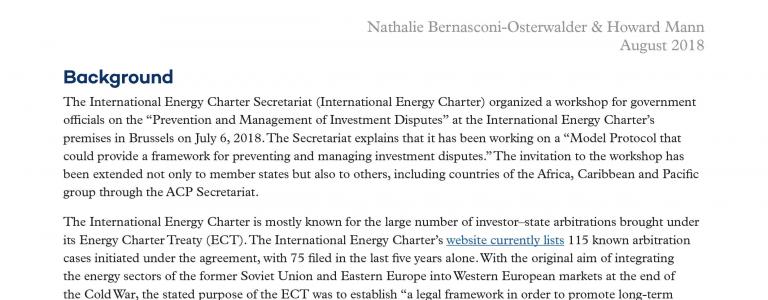International Energy Charter Draft Model Investment Dispute Prevention and Management Protocol
IISD legal analysis of the draft Model Investment Dispute Prevention and Management Protocol developed by International Energy Charter Secretariat.
The International Energy Charter Secretariat has developed a draft Model Investment Dispute Prevention and Management Protocol, aimed at providing a framework for states to prevent, manage and resolve investment disputes.
The draft addresses tasks, powers, decision making, information sharing, financial considerations, coordination among relevant agencies and individuals, state representation, among other topics, in relation to international investment disputes.
We understand that the topics covered by the so-called Protocol would be better served—at least from the perspective of state interests—by guidance and good practice materials as opposed to the effort to develop a legal or quasi-legal instrument creating additional legal jeopardy for states in an arbitration context.
IISD fully supports the view that governments should develop strong internal procedures for preventing and managing investment disputes. Indeed, we have assisted developing countries in doing so. This is a prudent and reasonable course of action.
However, that does not mean these steps should be legalized and turned into rigid documents with short timelines that can work to prevent states from developing strong positions and approaches as alternatives to arbitration. The proposed instrument is of little benefit to states on either account. It overreaches legally and underachieves in terms of being a really practical tool for governments. Instead, it creates new legal risks for states.
Background on the International Energy Charter
The International Energy Charter Secretariat is mostly known for the large number of investor–state arbitrations brought under its Energy Charter Treaty (ECT). With the original aim of integrating the energy sectors of the former Soviet Union and Eastern Europe into Western European markets at the end of the Cold War, the stated purpose of the ECT was to establish “a legal framework in order to promote long-term cooperation in the energy field.” Although the framework covers multilateral cooperation over energy transit, trade and efficiency, its primary focus has been on investment protection and international arbitration. The secretariat is looking to gain new resource-rich member countries in Africa, Asia and Latin America.
Download the draft Model Investment Dispute Prevention and Management Protocol.
You might also be interested in
The Hidden Clauses That Can Hinder Tax and Investment Policy Reform
Stabilization clauses should no longer automatically be included in contracts between states and investors. If they are, they should, at a minimum, build on the latest international standards on stabilization to avoid being a barrier to sustainable development.
What Drives Investment Policy-makers in Developing Countries to Use Tax Incentives?
The article explores the reasons behind the use of tax incentives in developing countries to attract investment, examining the pressures, challenges, and alternative strategies that exist.
Brussels push to ban ECT disputes gains traction
Two arbitration victories for Spain under the Energy Charter Treaty (ECT) have sparked hopes that efforts to halt the intra-EU disputes that dominate claims under the controversial global pact are starting to bear fruit. Climate scholars, like IISD's Lukas Schaugg, believe the tribunal wins this month signal growing acceptance in international legal circles that EU investors cannot bring ECT claims against other member state governments.
Sustainability rules to impact global trade
Developed countries should consult developing countries in crafting global sustainability rules to prepare these markets for the impact of stringent regulations that may hamper global trade, a United Nations official said at IISD's recent Investment Policy Forum.
